ADSactly History: The Bear Cult of the Primitive People
Hello, dear @adsactly readers. We continue our quest to understanding the spiritual evolution of our earliest ancestors by taking a look at their religious beliefs. In order to do this, we should use our imagination to try to understand what Neanderthals and Homo Sapiens made of a world that was full of mystery. If they looked at the sky, they knew the Sun brought light and warmth, but they didn’t know what it was. Presumably, they learned to tell it was going to rain if the sky was overcast, but they had no idea what thunder and lightening meant.
However, the first place they looked was around them, in their immediate vicinity - earth, trees, rivers and, above all, animals. For the Neanderthal, as well as for Homo Sapiens, the animals were the most important. Their lives depended on the creatures that roamed freely around them. Remember they were hunter-gatherers, so if they could not get enough meat, they starved. At the same time, bears and lions and rhinos could easily kill them. Naturally, the primitives first evolved animist beliefs. They populated their world with spirits of animals, plants, rivers.
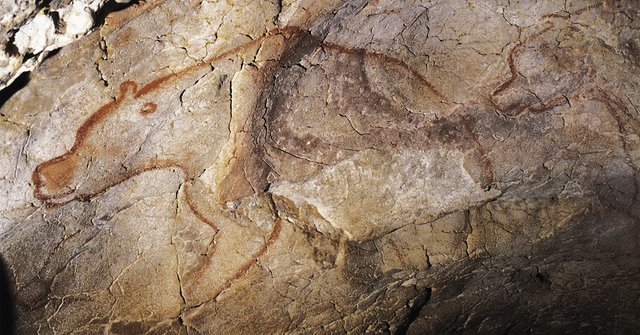
The Red Bears of the Chauvet Cave
source
The term animism was coined in 1871 by English anthropologist Edward Tylor, in his book ‘Primitive Culture’, in which he defined it as "the general doctrine of souls and other spiritual beings in general". His theory was based on observations about the religious beliefs of native populations in Africa or Asia, but it applies very well to primitive populations.
One of the first and most prevalent animist religion was bear worship, which could be found in most of the European continent, but went as far as Asia.
Anthropologists believe the cult of the bear appeared in the time of the Neanderthals, 50,000 years ago, maybe even more. Evidence of this cult are the numerous bear bones found in different caves inhabited by primitive people. The way the bones were arranged indicates some sort of ritual taking place. For instance, in a cave in France, at Saone-et-Loire, the bear skulls were arranged in a perfect circle. Other caves with bear remains arranged with particular care were found in Switzerland and Slovenia.
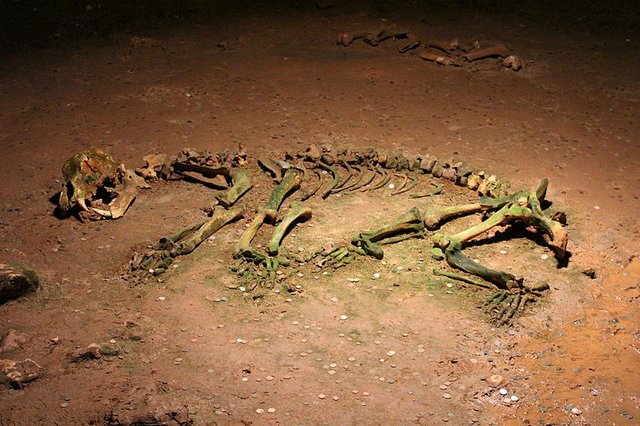
Fossil skeletal bear remains found in Germany in 1774
source
If you would like to learn more about this cult, you should definitely read ‘The Clan of the Cave Bear’, an excellent book by Jean M. Auel. It is a work of fiction set at a time Neanderthals and Homo Sapiens coexisted, the plot itself is fascinating, but the book’s greatest value lies in the unbelievable amount of research the author put into this work. If you’re interested in early human history, you can find in this book detailed descriptions of the most relevant aspects of their lives, from carving stone tools, to making the clothes on their backs to the technique of hunting mammoths with nothing but a few wooden spears.
According to Auel, Neanderthals had complex rituals and used totems to get protection from their spirit animals.
One of the most important proofs of the existence of this cult is the fact that up to this day, the bear is the central animal in many folkloric traditions around Europe.
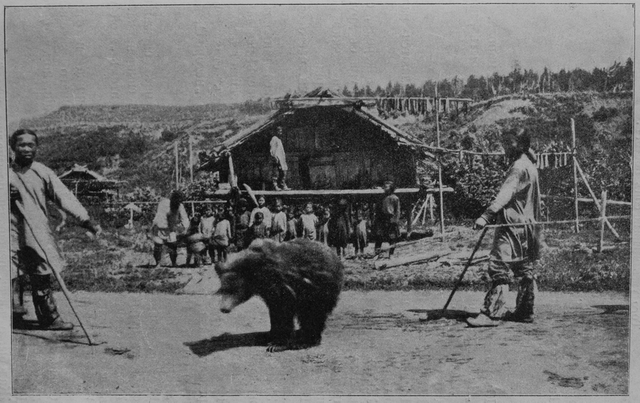
A bear festival of the Nivkh population, around 1903
source
In Ancient Slavic religions, the bear was associated with the god Volos, patron of domesticated animals.
Th indigenous Nivkh population which inhabited the Amur river valley in mainland Russia had a winter bear festival that survived till modern times, before being banned by the Soviets. The inter-clan festival, beautifully described in the book I mentioned, involved one of the groups capturing a bear cub and raising it as a child. Once it reached maturity, the bear would be slain in an elaborate ritual meant to release its spirit, an act which the Neanderthals thought would bring them favors from the animal deity.
In Romania where I live we still have a New Year tradition, called the Dance of the Bear, only nowadays it is performed with a man dressed as an animal. Folklorists believe it is a custom that has been preserved from pagan times. In fact, the greatest local god from before Christianity was called Zalmoxis, which it is believed meant ‘bear skin’.
Remnants of the old bear cult can also be found in Japan. The Ainu people who live on several Japanese islands call the animal kamuy, which means god in their language. The also have a winter festival which involves the slaying of a bear in a ceremony meant to return its spirit to its proper home.
Evidence of an ancient bear cult have also been found in northern Norway, near Alta, where more than 6000 rock carvings of animals have been found on several sites. The oldest among the carvings were dated to around 5000 BC. The bear is represented in such a position as to indicate the animal was not only hunted, but also worshiped. Of special interest to scientists are the vertical tracks that come out of the bear’s den, with one theory saying it represents a reference to the belief in after life and the bear’s ability to cross between realms.
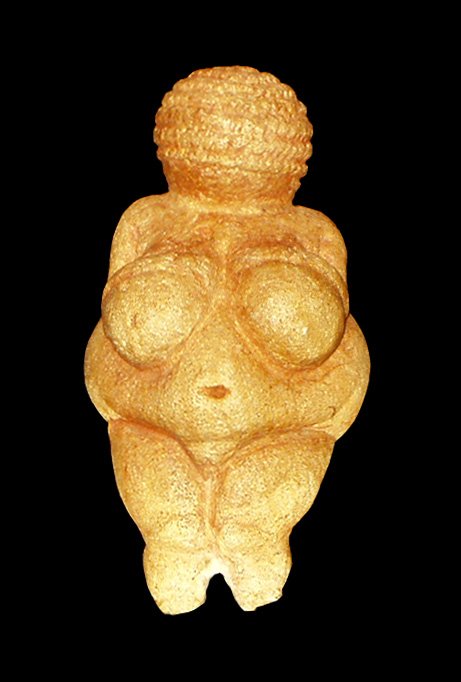
Venus of Willendorf, Austria
source
Some 40000 ago, in the Upper Paleolithic, another type of religious beliefs began to emerge. On various sites across Europe scientists have discovered small statues of women, generically referred to as Venus. It is believed the statues represented a goddess of fertility and were probably used in religious rituals.
Two ancient ritual statues have also been discovered by archaeologists on a Neolithic site in Romania. The most famous one, The Thinker of Hamangia, is considered by UNESCO on a short-list of the ten most precious prehistoric artifacts in the world. The Thinker is believed to represent some nature god, while the statue of the woman that was found with it is most probably a fertility goddess.
Moving from animal cults to more abstract anthropomorphic gods represents yet another step in the spiritual evolution of the primitive man. The fact that so many pagan traditions are still alive after such a long time indicates just how strong these beliefs were and how deeply they are rooted in our collective psyche.
Across Europe, bears are probably the most powerful animals, but in other regions of the world it could be that people feared and worshiped other beasts.What sort of animal cults have been preserved in your area?
Post authored by @ladyrebecca.
Click the coin below to join our Discord Server
)
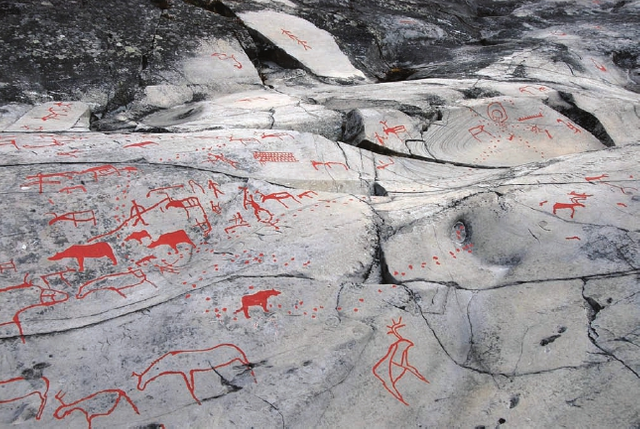
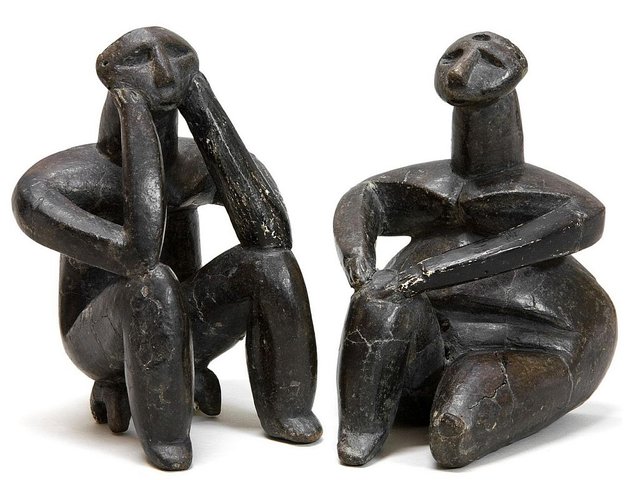
Great post.
I was given Auel's book many years ago and have postponed its reading (long waiting list). It's a massive book, part of a massive series that has a lot of credit because of the research, as you point out, the author put into it.
I hope to have the time to read at least The Clan of the Cave Bear.
Even though we have some varieties of small bears, bears do not stand out as important animals in folk traditions of beliefs.
The anaconda or the tapir are probably more remarkable, as it has been described in some posts here.
Yes, very long read😄 I have abandoned the series at the third volume, but I expect to pick it up again at some point.
Posted using Partiko Android
In Venezuela many of the ethnic groups adore animals, but others adore other elements of nature. Venezuelan indigenous mythology is full of creator gods of waters, rivers, trees, mountains. For example, there is the cult of Maria Lionza who is mother of nature. It is believed, for example, that she is the personification of some animals. She is recognized for having a feline and reptilian face. A snake held her captive and is represented on top of a tapir and accompanied by a panther. In some versions of the legend of this goddess, it is believed that she takes the form of an animal to help, but also to attack her enemy. In the Araguaca culture it is believed, for example, that some shamans or witches can assume the form of animals and from there they adore them. The most common are anacones, tigers and birds. These animals become their gods and represent for them the divine, so they do not kill them, or eat it and can even live with them. I liked reading this post, @ladyrebecca. ;) greetings
I have heard only vaguely about Maria Lionza, thank you for providing so much additional information!
Of great interest this series that you carry on, @ladyrebecca. Consider the animistic stage of the evolution of the human psyche is extremely relevant. I remember that the Spanish philosopher Maria Zambrano, in her book The Man and the Divine, reflecting on the relationship with mystery in primitive man points out that perhaps the first relationship with nature was one of delirium and terror at the unknown and the forces that overcame it. And the bear, as well as the illustras, is a representation of it, but in other regions the wild felines (tiger, leopard, jaguar) or the snakes, for example.
With regard to these fears, I think Jean-Jacques Annaud's films The War of Fire, The Bear and The Wolf are excellent.
When I saw "Venus de Willendorf" and "The Thinker", I was thinking about how modern painting and sculpture was nourished by primitive art (e.g. Picasso, Gauguin, Botero, etc.). By the way, I suppose you will devote more space later to talk about female divine representation (the so-called "mother goddesses").
Thanks for your good post, @ladyrebecca.
Yes, I expect other cultures devoted their attention to animals that were more feared in their area, which, as you say, must have caused a lot of terror to people who had only spears and rocks to defend themselves!
Great article. The presence of burial goods in non-human hominids does show a possible belief in an after-life and by corollary, a belief in the existence of of a soul. After all, something has to survive to experience the after-life.
The documentary Rise of the Warrior Apes has a poignant scene in which a chimp appears to be praying. Tantalizing possibility! Metaphysical beliefs may be a natural evolutionary development of primate intelligence.
The documentary you mention sounds quite interesting. I will look it up. Thanks for the info!
Dear me @ladyrebecca, first your owl entry and now this. Today I have learned a lot of very interesting stuff from you!
I loved "the Clan of the Cave Bear" when I read it long ago. I'll have to reread it now!
Me, too... I need to pick up the third book I abandoned months ago..
@ladyrebecca, We are missing so many parts of History because they are not yet came into light. What we know may be it's just a piece of the whole. But one thing is for sure and that is this world is so much mysterious and we are surrounded with Spiritual Realm because we can feel it. Stay blessed.
Posted using Partiko Android
Oh, indeed, I'm afraid it's only a very small piece, which is so frustrating...
OK, maybe we cannot know the future, but if we could at least know the past!
Yes, in my opinion if we understand the past then understanding future is possible to some extent because Life Is A Cycle.
Posted using Partiko Android